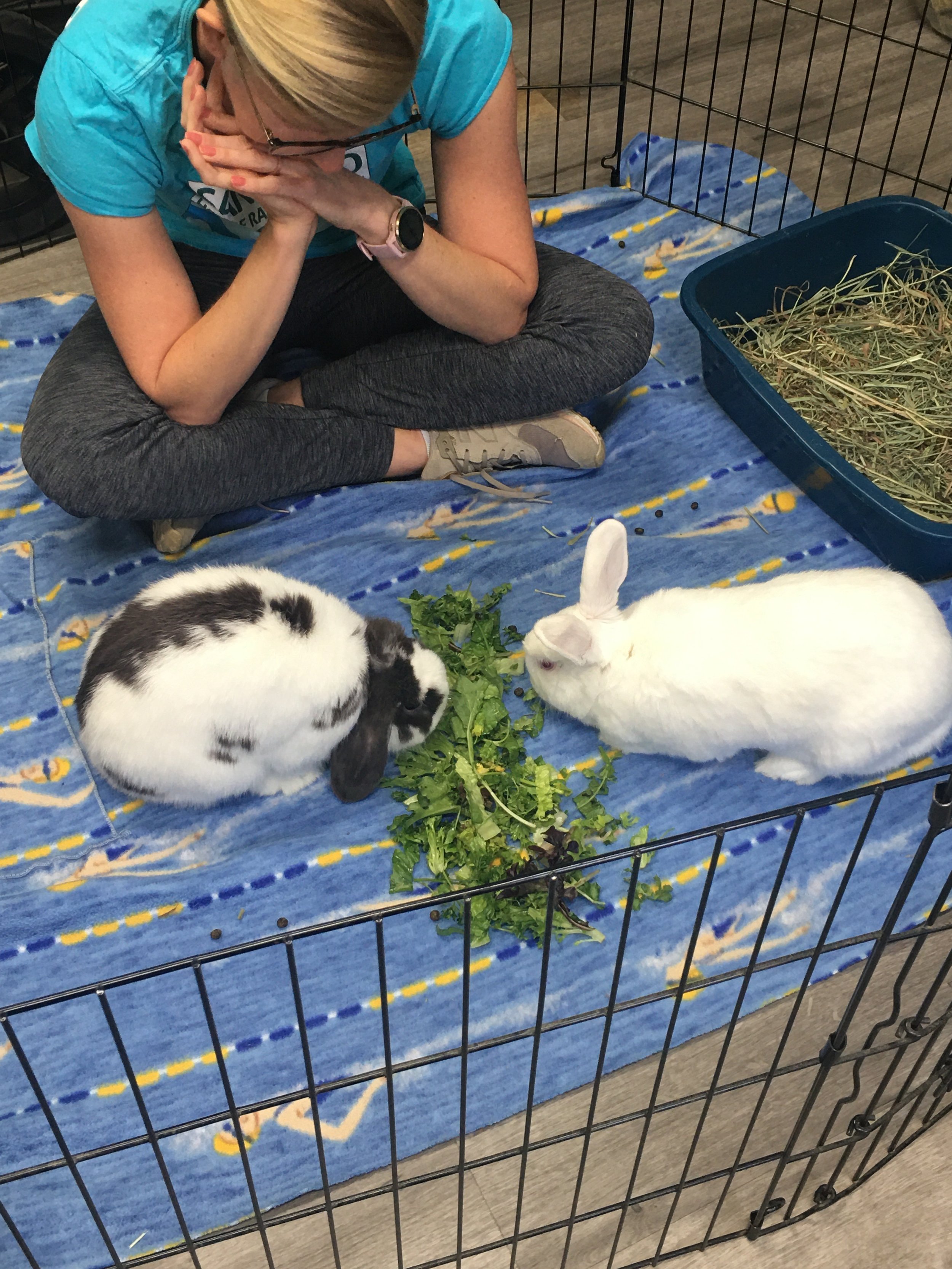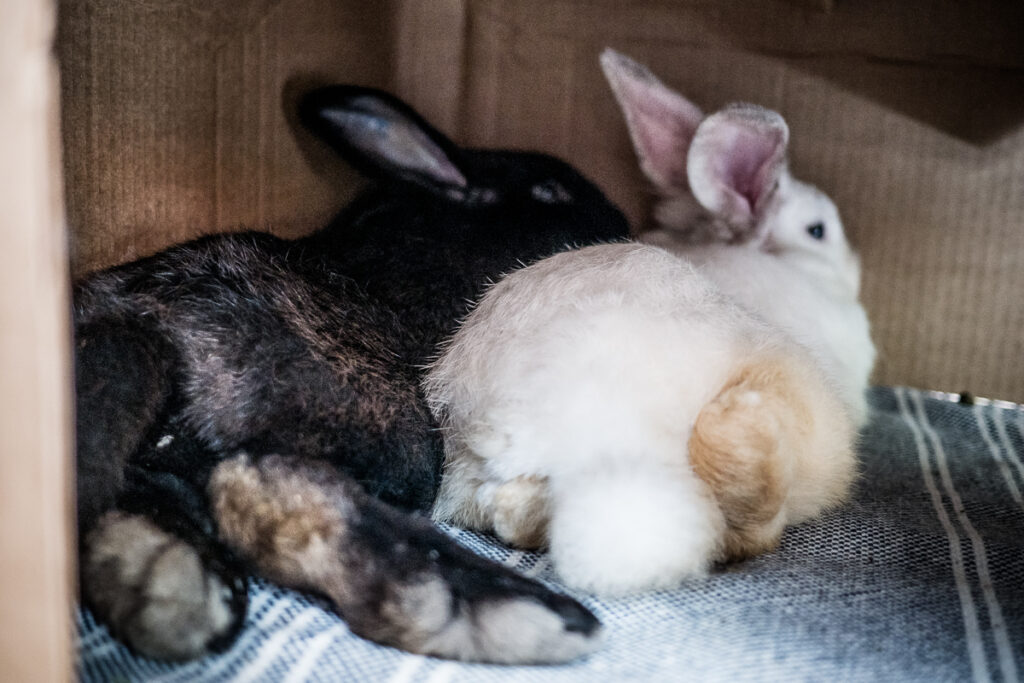Rabbits are naturally very social animals, and usually do best with a rabbit friend. Although they will form bonds with their humans, it is different from what they would share with a rabbit companion. They will provide emotional support to each other when one rabbit is sick, bored, lonely, or stressed. They love to nuzzle and groom each other, sleep on top of each other, and share a big plate of salad or a box of hay. Nothing is cuter than seeing bonded rabbits together! When rabbits bond, they bond for life.
Although they thrive with rabbit companionship, just like humans, rabbits have their own unique personalities and do not always get along with every other rabbit. The process of finding a partner for your rabbit can take time and patience, but it will be worth it in the end!
Note: Please consult an experienced bonding counselor to help you through your first bonding process. Bonding rabbits can be stressful, for both you and your rabbits! It is important to make sure you are bonding safely and effectively from the start. Please do not hesitate to reach out to SDHRS for help during all stages of the bonding journey.
First Things First
The first step to choosing a companion for your rabbit is to ensure that your rabbit is spayed or neutered, and has been given time to allow their hormones to dissipate — usually about four to six weeks after surgery. Male/female pairings are usually the easiest. After that, male/male bonds can sometimes be a little trickier, and female/female bonds are usually the most difficult to form. Every match is different so it will ultimately depend on the personalities of the rabbits involved. Most bonds involve two rabbits, but bonded groups of three to five rabbits can work out beautifully too.
Preparation Is Key
Before bringing a second rabbit into your home, you will need to plan for the bonding process. Where will the two rabbits live before they are fully bonded? They must be housed separately — but side-by-side — to give them time to get used to each other’s presence and scent. Deep clean your home (at least where the rabbits will frequent) to neutralize the scent as much as possible, so both rabbits feel like they are starting off on equal ground.
Keep 3-4 inches of space between the pens so that they are not able to bite or injure each other through the pens. For this period of the bonding process you will need to double up on your supplies: two litter boxes, food and water dishes, hidey boxes, bedding, etc. Place their food and litter boxes on the sides of the pen closest to each other, like a mirror, so they can start to practice being social even when they are separated.
All supervised interactions, or “bunny dates,” must occur in a neutral territory. This can be any place that your rabbit has not spent a lot of time in, or has not claimed as their own. Bathrooms, kitchens, hallways, or spare bedrooms can work well for this. Just be sure to thoroughly clean the area to remove any previous scent of your rabbit.
Once your rabbits are bonded, you will likely need to create a larger living space to accommodate both rabbits. If your current rabbit is “free roam,” don’t assume that your new rabbit will be able to handle that level of freedom right away. Plan to keep both rabbits confined during the bonding period and for a while afterward, until you are confident enough to gradually expand their space.
After they are fully bonded, DO NOT SEPARATE your rabbits! Rabbits bond for life and will become extremely stressed if separated from their bonded companion, and separating them may cause a reversion in the bonding.
Let Your Rabbit Choose

Like humans, rabbits prefer to choose their own companions. Bringing home a new rabbit to meet your current rabbit can often end in disaster… Especially if your current rabbit is a female. Do yourself a favor and let your rabbit choose!
The best way to do this is to take your rabbit to a local shelter or rabbit rescue to set up a “bunny speed dating” bonding appointment. An adoption counselor can introduce your rabbit to a few other rabbits to see which interaction(s) shows the most promise. Based on their behavior, the counselor can help you and your rabbit decide who the best candidate is, and a series of follow-up dates can be scheduled to strengthen the bond and ensure that this is a good match.
The Dating Period
Expect the bonding process (or dating period) to take anywhere from two weeks to about two months. Sometimes it takes less time and sometimes it takes more. The key to success is to take it slowly, always supervise dates well, and don’t pressure the bunnies to get along too soon. Rabbits need time to get used to each other’s presence, smells, sounds, and habits.
Supervising Bonding Dates
At first, supervise dates in a small area, about 4′ x 4′. Exercise pens work great, or you can also use the bathroom floor, bathtub, or a small enclosed area where you can maintain control. Set both rabbits down together and move them beside each other, with their heads pointing in the same direction. Pet them both, across the ears and down the back, to soothe and quiet them as they get used to the rabbit next to them. Pause for a bit, to see how they respond to each other’s presence.
Presenting their head for grooming, or leaning into the other is good. Nipping or chasing is not, but it can be a normal part of establishing their hierarchy. Keep a close watch to prevent negative behaviors such as lunging, nipping or chasing. Try to read the rabbit’s cues to prevent overly aggressive behavior from starting.
Intervening in Conflicts
If a fight does start, reach out and quickly place a hand on the head of the chaser and calm the rabbit. Slide them back beside each other and start over. As the rabbits begin to accept each other you can relax a bit and allow them more freedom to interact, still keeping a watchful eye. Dates may only last 5-20 minutes at first, and slowly increase in time until they are able to spend hours together.
Try to always end a date on a positive note, like with side-by-side snuggles, or mutual lounging. As the rabbits continue to get along well, you can expand the area where they interact, and allow them more time together. Eventually, once they can stay together for several hours without any problems, you can allow them play time outside of the enclosed area. Always keep a watchful eye to prevent any fighting. Once they go a whole day without problems, you can let them spend the night together (sleep in the same room with them for the first few nights to supervise).
Common Bonding Behaviors
During the bonding process, you will most likely observe most of these common behaviors. Most of them stem from the rabbits sorting out the hierarchy of their relationship. This is a necessary step to forming their relationship, but if it leads to fighting or more aggressive behavior you should definitely intervene to ensure that neither of the rabbits are injured.
Positive Bonding Behaviors
Ignoring: Rabbits may ignore each other at first. This is totally normal, and could very well be the start of a beautiful friendship once they become more comfortable with each other.
Mirroring: This is when one rabbit copies the behavior of the other rabbit, whether they are lying down, self-grooming, playing or eating. This is a good sign, and you will usually see them get closer and closer over time until they are eventually doing these behaviors together.
Grooming: Grooming is a great sign in the bonding process! Whether they are self-grooming or grooming each other, grooming can be a sign of comfort or affection. You may notice one rabbit putting their head down low in front of the other rabbit. This is their way of asking for grooming. It may take some time for the other rabbit to fulfill their request, but once they groom each other they are well on their way to becoming a fully bonded pair!
Flopping: A flopped rabbit is a relaxed rabbit, and flopping in the presence of another rabbit indicates that they are very comfortable and at ease with their new companion.
Bonding Behaviors That Need to Be Resolved
Nipping: Nipping will most likely happen at some point during the bonding process. It is normal and isn’t always a negative or aggressive action. Sometimes a rabbit will nip the other because they want to be groomed. Supervise to make sure that innocent nips do not turn into fighting or aggressive behavior.
Marking: It is normal for rabbits to mark their territory during the bonding process. Their litter box habits may temporarily fall apart or they will start pooping around their pen, especially along the side closest to the other rabbit. Once they are bonded, the marking should stop and their good litter box habits will resume.
Mounting: Between two altered rabbits, mounting is a way to establish dominance. Both male and female rabbits can mount as they sort out who is in charge in this relationship. If the submissive rabbit is not upset about being mounted, allowing it to happen for a few seconds lets the dominant rabbit know he/she can be dominant. Gently petting the submissive rabbit may help keep them calm. If the submissive rabbit will not tolerate it even for a few seconds, stop the dominant rabbit from mounting as it could lead to a fight. Once dominance is established, the mounting should subside.
*Do not allow a rabbit to mount their companion’s face, however, since that makes them vulnerable to biting!

Chasing: Just like mounting, chasing can be used to establish dominance. You may need to intervene if chasing leads to circling or aggressive behavior to avoid injury.
Fixing the Fighting
It’s not unusual for two rabbits to seem to like each other but still have scuffles. Dominance, territorial issues, and sometimes even jealousy can lead to fighting. You may have to resort to additional measures to get the rabbits to trust each other or seek out each other for comfort.
Pen Swap!: Regularly swapping their litter boxes, toys, and living spaces can help rabbits overcome their sense of distinct “mine” vs. “theirs” territories and helps them get used to sharing things with their prospective partner’s scent.
Mix Things Up: Another way to get rabbits to seek comfort from each other is to put them in odd situations at home. In a pet stroller while you do slow laps around the house, in a laundry basket while you carry them carefully from room to room. Sometimes just putting them in strange situations will help to enhance their dependence on one another for comfort.
Provide Distraction: Try adding a few toys, some cardboard boxes, and maybe even two separate litter boxes to the bonding area. This can provide enough distraction to keep the rabbits busy and intent on exploring rather than fighting. Anything that can gently distract them from aggressive behavior is good. Some people will clap their hands or whistle to interrupt aggressive behavior. Do NOT spray them with a spray bottle.
©Copyright San Diego House Rabbit Society. All Rights Reserved. Republished with the permission of the author.

